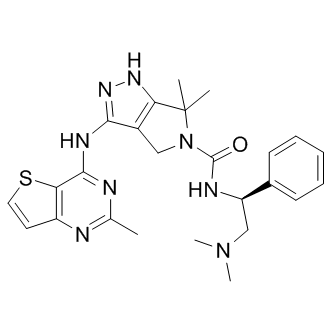All AbMole products are for research use only, cannot be used for human consumption.

PF-3758309 is an orally bioavailable small-molecule inhibitor of p21-activated kinase 4 (PAK4) with potential antineoplastic activity. PF-3758309 inhibits phosphorylation of the PAK4 substrate GEF-H1 (IC(50) = 1.3 nM) and anchorage-independent growth of a panel of tumor cell lines (IC(50) = 4.7 +/- 3 nM). PF-3758309 also inhibits cellular proliferation (IC50 = 20 nM) and anchorage-independent growth (IC50 = 27 nM) of A549 cells. PF-3758309 blocks the growth of multiple human tumor xenografts, with a plasma EC50 value of 0.4 nM in the most sensitive model. In tumor models, PF-3758309 inhibits PAK4-dependent pathways in proteomic studies and regulates functional activities related to cell proliferation and survival.
| Cell Experiment | |
|---|---|
| Cell lines | HEK293T, HCT116, and SKOV3 cells |
| Preparation method | Using a panel of cancer cell lines test the potency of PF-3758309. On day 1, plating cells on 384-well plates. On day 2, adding compounds to the cell culture. Incubating the cells with the compound for 3 days. On day 5, aspirating all media from the wells. Dose-dependent effects of PF-3758309 on cell proliferation are quantified via the CellTiter-Glo Luminescent Cell Viability Assay(a,b,c), which is a homogeneous method of determining the number of viable cells in culture based on quantitation of the ATP present, an indicator of metabolically active cells. Proliferation data displayed for HEK293T, HCT116, and SKOV3 cells are measured using the Cyquant NF assay as specified by the manufacturer. Briefly, 24 h after seeding on 384-well plates, cells are treated with vehicle or PF-3758309, Dasatinib, or the positive control, Bleomycin (60 mU/ mL).After drug treatment for 72 hours, cell proliferation is measured. Results for each drug are normalized to vehicle control and expressed as a percentage of maximum assay inhibition relative to Bleomycin. Error bars represent the SD from at least three experiments |
| Concentrations | ~1 μM |
| Incubation time | 72 hours |
| Animal Experiment | |
|---|---|
| Animal models | Xenograft tumors in nude mice |
| Formulation | 0.5% methylcellulose |
| Dosages | 7.5-30 mg/kg BID |
| Administration | p.o. |
| Molecular Weight | 490.62 |
| Formula | C25H30N8OS |
| CAS Number | 898044-15-0 |
| Solubility (25°C) | DMSO 10 mM |
| Storage |
Powder -20°C 3 years ; 4°C 2 years In solvent -80°C 6 months ; -20°C 1 month |
[1] Zhao ZS, et al. F1000 Biol Rep. Do PAKs make good drug targets?
| Related PAK Products |
|---|
| st-Ht31
st-Ht31 is a membrane-permeable peptide inhibitor of protein kinase A (PKA) anchoring. |
| AZA197
AZA197 is a selective small molecule inhibitor of Cdc42.AZA197 suppresses colon cancer cell proliferation, cell migration, invasion and increases apoptosis by down-regulating the PAK1 and ERK signaling pathways in vitro. |
| ZMF-23
ZMF-23 is a PAK1/HDAC6 dual inhibitor. |
| PF-3758309 dihydrochloride
PF-3758309 (PF-03758309) dihydrochloride is a potent, orally available, and reversible ATP-competitive inhibitor of PAK4 (Kd= 2.7 nM; Ki=18.7 nM). PF-3758309 dihydrochloride has the expected cellular functions of a PAK4 inhibitor: inhibition of anchorage-independent growth, induction of apoptosis, cytoskeletal remodeling, and inhibition of proliferation. |
| AZ13705339 hemihydrate
AZ13705339 hemihydrate is a highly potent and selective PAK1 inhibitor with IC50s of 0.33 nM and 59 nM for PAK1 and pPAK1, respectively. AZ13705339 hemihydrate has binding affinities to PAK1 and PAK2, with Kds of 0.28 nM and 0.32 nM, respectively. AZ13705339 hemihydrate can be used in the research of cancers. |
All AbMole products are for research use only, cannot be used for human consumption or veterinary use. We do not provide products or services to individuals. Please comply with the intended use and do not use AbMole products for any other purpose.


Products are for research use only. Not for human use. We do not sell to patients.
© Copyright 2010-2024 AbMole BioScience. All Rights Reserved.
